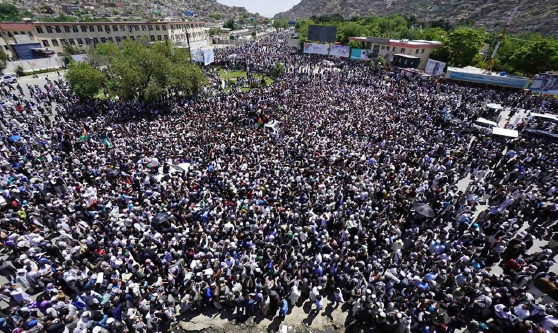
The Safe Schools Declaration: Protecting Schools During Wartime
Reading time: (Number of words: )
The blood stains on the classroom walls couldn’t be washed away following the Taliban attack on the middle school in Postak Bazaar village in Afghanistan. ‘We had to chip it away from the wall with an axe,’ a school official told Human Rights Watch.
But the blood wasn’t that of the school’s students. It was that of seven members of the Afghan National Police, a counter-insurgency force that had set up their military base inside the school. That attack was in 2010. After the Taliban retook the area, their fighters too slept in the school.
By 2015, government forces were back, and established their base with sandbagged positions on the second floor, while students tried to continue their schooling below.
Alarmed school officials obtained a letter from the Kabul authorities ordering the forces to leave, but their commander ignored it. At exam time, school officials again presented the letter, but the soldiers fired their guns toward the assembled teachers and students, who fled.
Since the Australia-supported military intervention in Afghanistan began in 2001, foreign donors have invested heavily in education, building schools and providing textbooks across the country. The expansion of education in Afghanistan, especially for girls, has been one of the success stories of the past 15 years. But as the security situation has deteriorated, schools throughout Afghanistan have been under threat, not only from resurgent Taliban forces but also from the Afghan state security forces mandated to protect them.
But it’s not just in Afghanistan that schools are under attack, or are being taken over by military forces. In the majority of countries with armed conflict around the world, schools are being attacked and used for military purposes, often converted into military bases or barracks. As the middle school in Postak Bazaar illustrates, the military use of schools not only turns schools into targets for attack, but the presence of armed forces inside a school can also interfere with education even if the school continues operating.
On 1 June, Australia’s Foreign Minister Julie Bishop announced the government would contribute $2 million to improve education for children in emergencies, including facilitating safe places to learn.
But there’s one more thing Australia could do to protect children’s education in emergencies, and it doesn’t cost a cent: endorse the Safe Schools Declaration. The Safe Schools Declaration (not to be confused with the ‘Safe Schools’ program for LGBT students being debated in Australia) marks an inter-governmental political commitment where countries pledge to protect students, teachers, schools and universities from attack during times of war. Last month marked its two-year anniversary.
So far 66 nations have endorsed the declaration aimed at ending the use of schools by militaries or armed groups. But Australia isn’t yet one of them. The declaration builds a community of nations committed to respecting the civilian nature of schools and developing and sharing examples of good practices for protecting schools during war. Countries that join agree to restore access to education faster when schools are attacked, and to make it less likely that students, teachers and schools will be attacked in the first place. They seek to deter such attacks by promising to investigate and prosecute war crimes involving schools. And they agree to minimise the use of schools for military purposes so they don’t become targets for attack.
On 13 February, some members of the Australian Parliament urged the government to join an international effort to protect students, teachers and schools in countries affected by war.
MPs Chris Hayes, Trent Zimmerman, and Maria Vamvakinou laid out the chilling details of how students and schools are all too frequently deliberately attacked during armed conflict, pointing to examples in Afghanistan, Iraq, Nigeria, South Sudan and Syria.
In response to a question on notice on 17 March, the Attorney-General George Brandis stated that the government had decided not to endorse the Safe Schools Guidelines and Declaration ‘as we assess they do not reflect existing international humanitarian law’. But in fact, countries such as the Netherlands and Switzerland, which have centuries-old traditions of professional militaries, were among the first to join the declaration.
The Declaration doesn’t create a legal obligation, but is a political commitment. Indeed, the International Committee of the Red Cross, which is traditionally seen as the guardian of international humanitarian law, has actively disseminated the guidelines to its staff.
As both Hayes and Zimmerman noted, when Australia was on the United Nations Security Council in 2014, it felt it appropriate to encourage other countries to take action to protect schools. Australia used its vote to encourage all countries to consider concrete measures to deter military use of schools.
Australia’s Ambassador to the UN, Gary Quinlan, told the Security Council members that using schools for military purposes gravely endangers the lives of children. ‘We need to do more to protect schools, teachers, and students during conflict,’ Quinlan relayed to the UNSC. ‘The child victims around the world count on us.’
Quinlan, representing the Australian government, was spot on. On 15 May UN Secretary-General Antonio Guterres urged all UN member states to endorse the declaration. It’s now time for Australia to rediscover the position it held in 2014.
View online : https://www.hrw.org/news/2017/...

Poems for the Hazara
The Anthology of 125 Internationally Recognized Poets From 68 Countries Dedicated to the Hazara
Order Now









